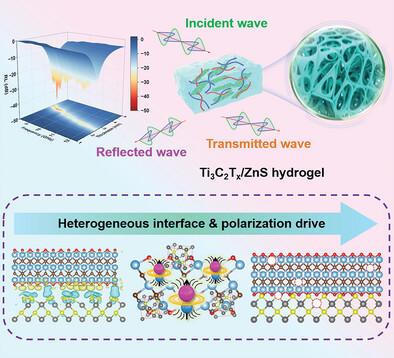当前位置:
X-MOL 学术
›
Adv. Funct. Mater.
›
论文详情
Our official English website, www.x-mol.net, welcomes your
feedback! (Note: you will need to create a separate account there.)
Schottky Interface Engineering in Ti3C2Tx/ZnS Organic Hydrogels for High-Performance Multifunctional Flexible Absorbers
Advanced Functional Materials ( IF 18.5 ) Pub Date : 2024-11-17 , DOI: 10.1002/adfm.202417346 Yuhong Cui, Guoliang Ru, Tianyi Zhang, Ke Yang, Shujuan Liu, Weihong Qi, Qian Ye, Xuqing Liu, Feng Zhou
Advanced Functional Materials ( IF 18.5 ) Pub Date : 2024-11-17 , DOI: 10.1002/adfm.202417346 Yuhong Cui, Guoliang Ru, Tianyi Zhang, Ke Yang, Shujuan Liu, Weihong Qi, Qian Ye, Xuqing Liu, Feng Zhou

|
With the rapid advancement of wearable electronics, soft robotics, and camouflage technologies, there is an urgent demand for flexible, multifunctional electromagnetic wave absorbing materials. Traditional absorbers, including metal- and carbon-based materials, often lack the flexibility required for such applications. In this work, a novel strategy is proposed for developing a flexible absorber by combining a conductive filler with a Schottky heterogeneous interface and a polymer network framework. Ti3C2Tx MXene is modified with ZnS via a low-temperature hydrothermal method, forming a Ti3C2Tx/ZnS composite. This composite is subsequently embedded in a copolymer matrix of polyvinyl alcohol (PVA) and acrylamide (AAm), dispersed in a binary water-glycerol solution. The Schottky interface between Ti3C2Tx and ZnS enhances electron transfer at the heterophase boundary, significantly improving interface polarisation. Simultaneously, interactions between water and glycerol restrict the rotation of polar molecules under external electromagnetic fields, optimising polarisation loss within the gel. Experimental results demonstrate that the Ti3C2Tx/ZnS gel achieves a minimum reflection loss (RLmin) of −43.76 dB at 8.79 GHz, with an effective absorption bandwidth (EAB) covering the entire X-band. Additionally, the gel exhibit exceptional stretchability, frost resistance, shape adaptability, and photothermal conversion properties.
中文翻译:

Ti3C2Tx/ZnS 有机水凝胶中的肖特基界面工程用于高性能多功能柔性吸收剂
随着可穿戴电子产品、软机器人和伪装技术的快速发展,对柔性、多功能电磁波吸收材料的需求迫切。传统的吸收材料,包括金属和碳基材料,通常缺乏此类应用所需的灵活性。在这项工作中,提出了一种通过将导电填料与肖特基异质界面和聚合物网络框架相结合来开发柔性吸收剂的新策略。Ti3C2Tx MXene 通过低温水热法用 ZnS 改性,形成 Ti3C2Tx/ZnS 复合材料。该复合材料随后嵌入聚乙烯醇 (PVA) 和丙烯酰胺 (AAm) 的共聚物基质中,分散在二元水甘油溶液中。Ti3C2Tx 和 ZnS 之间的肖特基界面增强了异质相边界处的电子转移,从而显着改善了界面极化。同时,水和甘油之间的相互作用限制了极性分子在外部电磁场下的旋转,从而优化了凝胶内的极化损失。实验结果表明,Ti3C2Tx/ZnS 凝胶在 8.79 GHz 时实现了 -43.76 dB 的最小反射损耗 (RLmin),有效吸收带宽 (EAB) 覆盖了整个 X 波段。此外,该凝胶还表现出优异的拉伸性、抗冻性、形状适应性和光热转换特性。
更新日期:2024-11-18
中文翻译:

Ti3C2Tx/ZnS 有机水凝胶中的肖特基界面工程用于高性能多功能柔性吸收剂
随着可穿戴电子产品、软机器人和伪装技术的快速发展,对柔性、多功能电磁波吸收材料的需求迫切。传统的吸收材料,包括金属和碳基材料,通常缺乏此类应用所需的灵活性。在这项工作中,提出了一种通过将导电填料与肖特基异质界面和聚合物网络框架相结合来开发柔性吸收剂的新策略。Ti3C2Tx MXene 通过低温水热法用 ZnS 改性,形成 Ti3C2Tx/ZnS 复合材料。该复合材料随后嵌入聚乙烯醇 (PVA) 和丙烯酰胺 (AAm) 的共聚物基质中,分散在二元水甘油溶液中。Ti3C2Tx 和 ZnS 之间的肖特基界面增强了异质相边界处的电子转移,从而显着改善了界面极化。同时,水和甘油之间的相互作用限制了极性分子在外部电磁场下的旋转,从而优化了凝胶内的极化损失。实验结果表明,Ti3C2Tx/ZnS 凝胶在 8.79 GHz 时实现了 -43.76 dB 的最小反射损耗 (RLmin),有效吸收带宽 (EAB) 覆盖了整个 X 波段。此外,该凝胶还表现出优异的拉伸性、抗冻性、形状适应性和光热转换特性。


















































 京公网安备 11010802027423号
京公网安备 11010802027423号